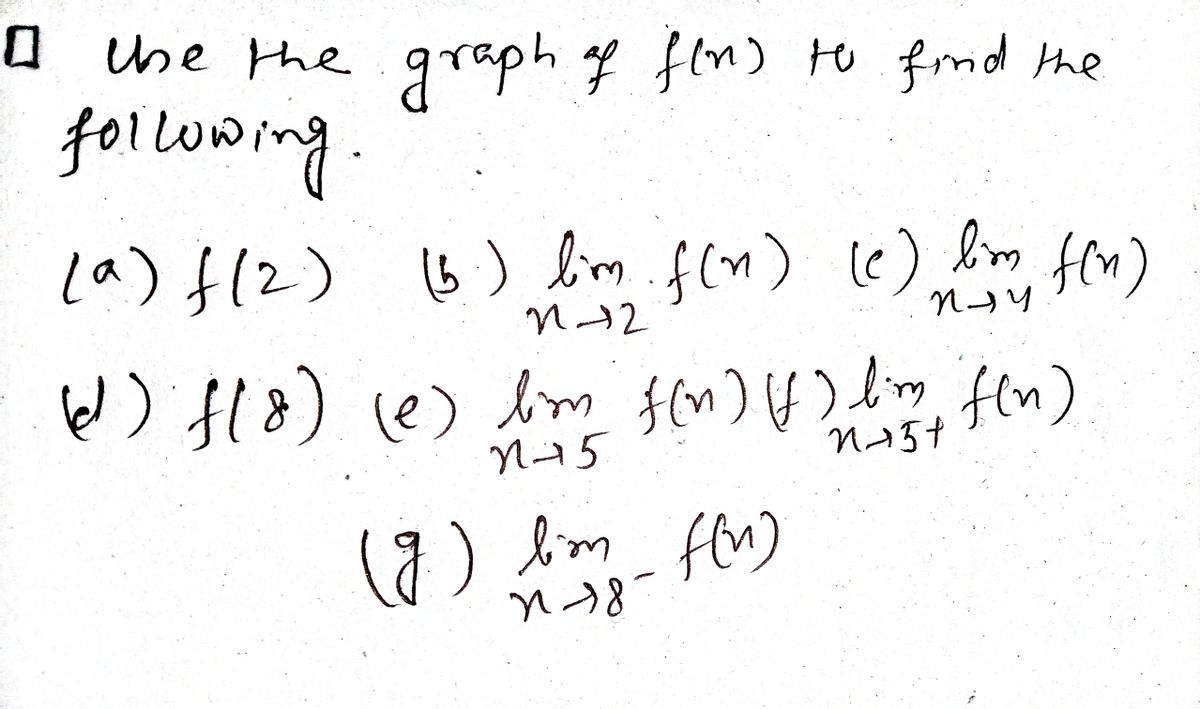1. Use the graph of f(x) shown to the right to find the following. If a quantity does not exist, write "DNE," and explain why the quantity does not exist. (a) f(2) (b) lim f(x) (c) lim f(x) x (d) f(8) (e) lim f(x) G4x (f) lim f(x) x+5+ (g) lim f(x) -84x 4 2 2 4 8t
1. Use the graph of f(x) shown to the right to find the following. If a quantity does not exist, write "DNE," and explain why the quantity does not exist. (a) f(2) (b) lim f(x) (c) lim f(x) x (d) f(8) (e) lim f(x) G4x (f) lim f(x) x+5+ (g) lim f(x) -84x 4 2 2 4 8t
Calculus: Early Transcendentals
8th Edition
ISBN:9781285741550
Author:James Stewart
Publisher:James Stewart
Chapter1: Functions And Models
Section: Chapter Questions
Problem 1RCC: (a) What is a function? What are its domain and range? (b) What is the graph of a function? (c) How...
Related questions
Question

Transcribed Image Text:Homework 2 Math 161-001
Note: Please do these problems on your own paper, and not on this assignment sheet, so that there's
plenty of space to write legibly and show your work. Then upload a pdf file of your work to Canvas.
1. Use the graph of f(x) shown to the right to find the following.
If a quantity does not exist, write "DNE," and explain why the
quantity does not exist.
(a) f(2)
(b) lim f(x)
x→2
(c) lim f(x)
x 4
(d) f(8)
f(x)
(e) lim f(x)
x→5
=
(f) lim f(x)
x→5+
(g) lim f(x)
2. To the right, you are given the graph of the function
2x 2
x-1
-8-x
2x - 2
(a) Use the graph to estimate the value of lim
x 1 x
(b) Use a table of values to estimate the value of the limit from
part (a) to within 0.001 of its true value. Show your table,
and clearly indicate your final answer.
2
2
1
Y
2
1
8 t
2
X
Expert Solution
Step 1

Step by step
Solved in 2 steps with 2 images

Recommended textbooks for you

Calculus: Early Transcendentals
Calculus
ISBN:
9781285741550
Author:
James Stewart
Publisher:
Cengage Learning

Thomas' Calculus (14th Edition)
Calculus
ISBN:
9780134438986
Author:
Joel R. Hass, Christopher E. Heil, Maurice D. Weir
Publisher:
PEARSON

Calculus: Early Transcendentals (3rd Edition)
Calculus
ISBN:
9780134763644
Author:
William L. Briggs, Lyle Cochran, Bernard Gillett, Eric Schulz
Publisher:
PEARSON

Calculus: Early Transcendentals
Calculus
ISBN:
9781285741550
Author:
James Stewart
Publisher:
Cengage Learning

Thomas' Calculus (14th Edition)
Calculus
ISBN:
9780134438986
Author:
Joel R. Hass, Christopher E. Heil, Maurice D. Weir
Publisher:
PEARSON

Calculus: Early Transcendentals (3rd Edition)
Calculus
ISBN:
9780134763644
Author:
William L. Briggs, Lyle Cochran, Bernard Gillett, Eric Schulz
Publisher:
PEARSON

Calculus: Early Transcendentals
Calculus
ISBN:
9781319050740
Author:
Jon Rogawski, Colin Adams, Robert Franzosa
Publisher:
W. H. Freeman


Calculus: Early Transcendental Functions
Calculus
ISBN:
9781337552516
Author:
Ron Larson, Bruce H. Edwards
Publisher:
Cengage Learning